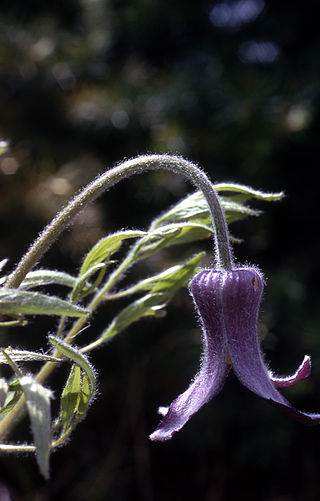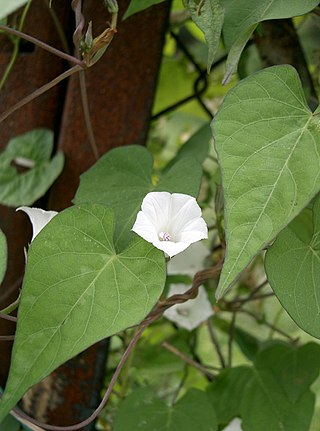
Kerria japonica, commonly known as Japanese kerria or Japanese rose, is a deciduous, yellow-flowering shrub in the rose family (Rosaceae), native to China, Japan and Korea. It is the only species in the genus Kerria. In the wild, it grows in thickets on mountain slopes. Japanese kerria has been used for medicine and is also planted in gardens. A double-flowered cultivar, K. japonica 'Pleniflora', is commonly called bachelor's buttons.

Rudbeckia triloba, the browneyed or brown-eyed susan, thin-leaved coneflower or three-leaved coneflower, is a species of flowering plant in the family Asteraceae with numerous, yellow, daisy-like flowers. It is native to the central and eastern United States and is often seen in old fields or along roadsides. It is also cultivated as an ornamental.

Campanula trachelium, the nettle-leaved bellflower, is a species of bellflower. It is a Eurasian blue wildflower native to Denmark and England and now naturalized in southeast Ireland. It is also found southward through much of Europe into Africa.

Nymphaea pubescens, the hairy water lily or pink water-lily, is a species of water lily.

Iris spuria, or blue flag, is a species of the genus Iris, part of the subgenus Limniris and the series Spuriae. It is a rhizomatous perennial plant, from Europe, Asia and Africa. It has purple or lilac flowers, and slender, elongated leaves. It is widely cultivated as an ornamental plant in temperate regions and hybridized for use in the garden. It has several subspecies; Iris spuria subsp. carthaliniae B.Mathew, Iris spuria subsp. demetrii B.Mathew, Iris spuria subsp. maritima (Dykes) P.Fourn. and Iris spuria subsp. musulmanica (Fomin) Takht. It used to have 3 other subspecies, which have now been re-classified as separate species; Iris spuria subsp. halophila, Iris spuria ssp. sogdiana and Iris spuria subsp. notha . It has many common names including 'blue iris', 'spurious iris' and 'bastard iris'.

Kickxia is a genus of plants in the plantain family (Plantaginaceae). It includes several species known commonly as cancerworts or fluellins. Species are mostly native to Europe, Central Asia, and Africa, with two, K. elatine and K. spuria, well-established as invasive elsewhere.

Ambrosia acanthicarpa is a North American species of bristly annual plants in the family Asteraceae. Members of the genus Ambrosia are called ragweeds. The species has common names including flatspine bur ragweed, Hooker's bur-ragweed, annual burrweed, annual bur-sage, and western sand-bur. The plant is common across much of the western United States and in the Prairie Provinces of Canada.

Epilobium densiflorum is a species of willowherb known by the common names denseflower willowherb, dense spike-primrose or dense boisduvalia. It is native to western North America from British Columbia to Baja California, where it is found in a variety of habitats. This is an erect annual often exceeding a meter in height with fuzzy green foliage. The pointed leaves are up to 8 centimeters long near the base of the plant, and the upper leaves are generally more hairy than the lower. The stem may branch or not. The top of the stem is occupied by a hairy, leafy, densely flowered inflorescence. Each flower has four deeply notched petals in shades of pinkish purple to nearly white with dark veining, each about a centimeter long. The fruit is a cylindrical capsule about a centimeter long.

Epilobium palustre is a species of willowherb known by the common name marsh willowherb. This plant has a circumboreal distribution, and can be found farther south in mountainous areas.

Erodium malacoides is a species of flowering plant in the geranium family known by the common names Mediterranean stork's bill, soft stork's-bill and oval heron's bill. This is an annual or biennial herb which is native to much of Eurasia and North Africa but can be found on most continents where it is an introduced species.

Clematis hirsutissima is a species of flowering plant in the buttercup family known by the common name hairy clematis or vase flower. It is a perennial herb that is native to much of the western United States, from Washington to Nebraska. It is a small, erect plant which, unlike other Clematis, does not generally produce vines. It is quite variable in appearance, especially across varieties. In general the hairy stem reaches up to about half a meter tall and has many large hairy leaves divided into lance-shaped lobes. The inflorescence appears at the tip of the stem and bears a solitary flower. The flower is made up of an urn-shaped cup of deep purple-blue petal like sepals, which are fuzzy and have pointed or rounded tips. Rare individuals have white or pinkish sepals. There are no true petals. The fruit is a hairy achene with a very long beak and a plume on the end; it is dispersed by wind.

Kickxia elatine is a species of flowering plant in the family Plantaginaceae. It is native to Europe and Asia, but it is present on other continents as an introduced species, and sometimes a noxious weed.

Layia chrysanthemoides is a species of flowering plant in the family Asteraceae known by the common name smooth tidytips, or smooth layia.

Potentilla norvegica is a species of cinquefoil known by the common names rough cinquefoil, ternate-leaved cinquefoil, and Norwegian cinquefoil. It is native to Europe, Asia, and parts of North America, and it can be found elsewhere as an introduced species.
Packera ganderi is a rare species of flowering plant in the aster family known by the common name Gander's ragwort. It is endemic to southern California, where it is known from a few occurrences in San Diego and Riverside Counties.
British NVC community OV15 is one of the open habitat communities in the British National Vegetation Classification system. It is one of two arable weed communities of light lime-rich soils.

Ipomoea lacunosa, the whitestar, white morning-glory or pitted morning-glory, is a species that belongs to the genus Ipomoea. In this genus most members are commonly referred to as "morning glories". The name for the genus, Ipomoea, has root in the Greek words ips and homoios, which translates to worm-like. This is a reference to the plant's vine-like growth. Lacunosa comes from a Latin word meaning air spaces, correlating with the venation of the leaves. Ipomoea lacunosa is native to the United States and grows annually. The flowers of this species are usually white and smaller than most other morning glories.

Geranium nodosum, the knotted crane's-bill, is a perennial herbaceous plant in the family Geraniaceae.

Hypericum hirsutum is a species of flowering plant in the family Hypericaceae, commonly known as hairy St John's-wort. It is found in Western Europe.

Iris series Spuriae are a series of the genus Iris, in Iris subg. Limniris. They are sometimes commonly known as butterfly irises.


















